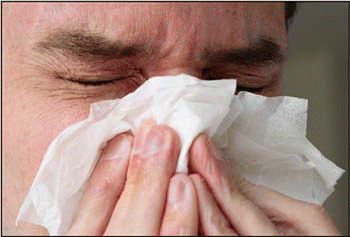 “Not many environmental factors appear to have much of an effect—except stopping smoking and reducing exposure to secondhand smoke.”
“Not many environmental factors appear to have much of an effect—except stopping smoking and reducing exposure to secondhand smoke.”Explore This Issue
December 2007—Robert M. Naclerio, MD
“We speculate that inflammation in nonsmoking individuals with asthma increases the conditioning capacity, and reducing it with in intranasal steroid worsens the ability of the nose to condition air. In addition, smoking interferes with the effect of the intranasal steroids.”
Antihistamines and Decongestants
Dr. Naclerio had some news for the audience: cetirizine (Zyrtec) will be sold over the counter beginning in 2008, and a new drug called levocetirizine, a modified form of Zyrtec, will be available by prescription in the American market soon.
In the world of decongestants, he stated that in a meta-analysis, oral phenylephrine was shown to have no efficacy whatever, and therefore patients should be discouraged from spending their money on it. On the other hand, “pseudoephedrine [Sudafed], which has efficacy, has been put away behind the drugstore counter so patients will have to show identification to purchase it. This discourage some patients from buying it.”

Intranasal steroids should be first-line treatment for symptoms of SAR because they are very effective. A new intranasal steroid, fluticasone furoate, was recently approved for sale in the United States.
Dr. Baroody described a study he conducted with colleagues in which montelukast (Singulair) was compared with pseudoephedrine for the treatment of SAR. The two-week trial was randomized, double-blind, and enrolled 58 adults with ragweed rhinitis.
After recording their own baseline nasal symptoms, nasal peak inspiratory flow, and diurnal and nocturnal rhinoconjunctivitis quality of life score, the patients were randomized to receive daily morning oral doses of 240 mg of pseudoephedrine hydrochloride or 10 mg of montelukast sodium. They recorded their nasal symptoms twice daily, and at the end of the study, they completed another quality of life questionnaire.
Dr. Baroody said that both treatments resulted in significant improvement in all symptoms of allergic rhinitis, as well as in overall quality of life. There were no significant differences between the two drugs except for nasal congestion, where pseudoephedrine was more effective. Surprisingly, both drugs were equally well tolerated.
Immunotherapy
 We speculate that inflammation in nonsmoking individuals with asthma increases the conditioning capacity, and reducing it with in intranasal steroid worsens the ability of the nose to condition air. In addition, “smoking interferes with the effect of the intranasal steroids.”
We speculate that inflammation in nonsmoking individuals with asthma increases the conditioning capacity, and reducing it with in intranasal steroid worsens the ability of the nose to condition air. In addition, “smoking interferes with the effect of the intranasal steroids.”
—Jayant M. Pinto, MD
Dr. Baroody told the audience that subcutaneous immunotherapy (SCIT) is effective for SAR and for prevention of asthma. SCIT involves an initiation period followed by three to five years of maintenance treatment. Dr. Baroody warned, however, SCIT is not without risk of anaphylactic reaction. Sublingual immunotherapy (SLIT)—for example, phleum pratense vaccine (Grazax)—is also effective, as are replicon DNA vaccines.
Leave a Reply